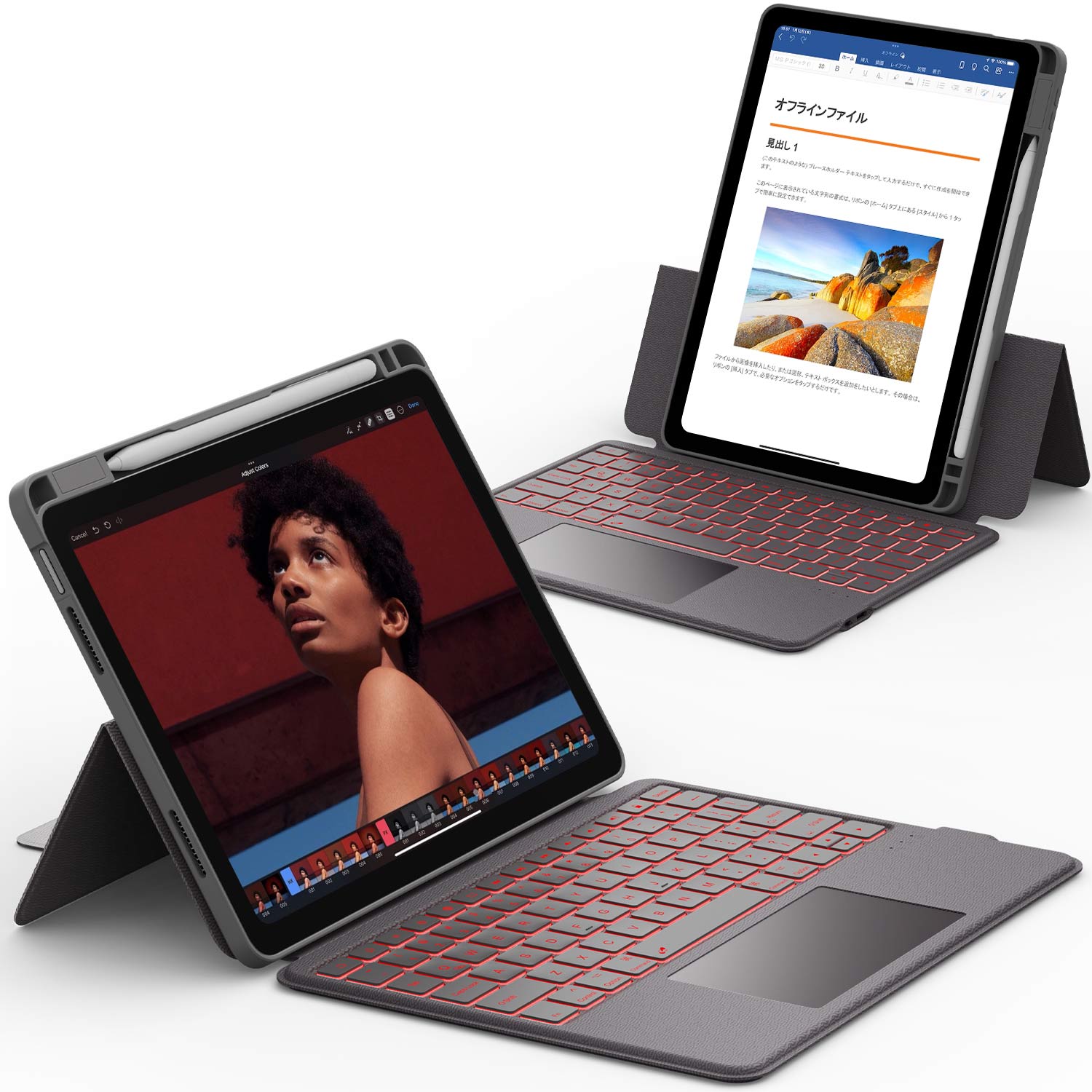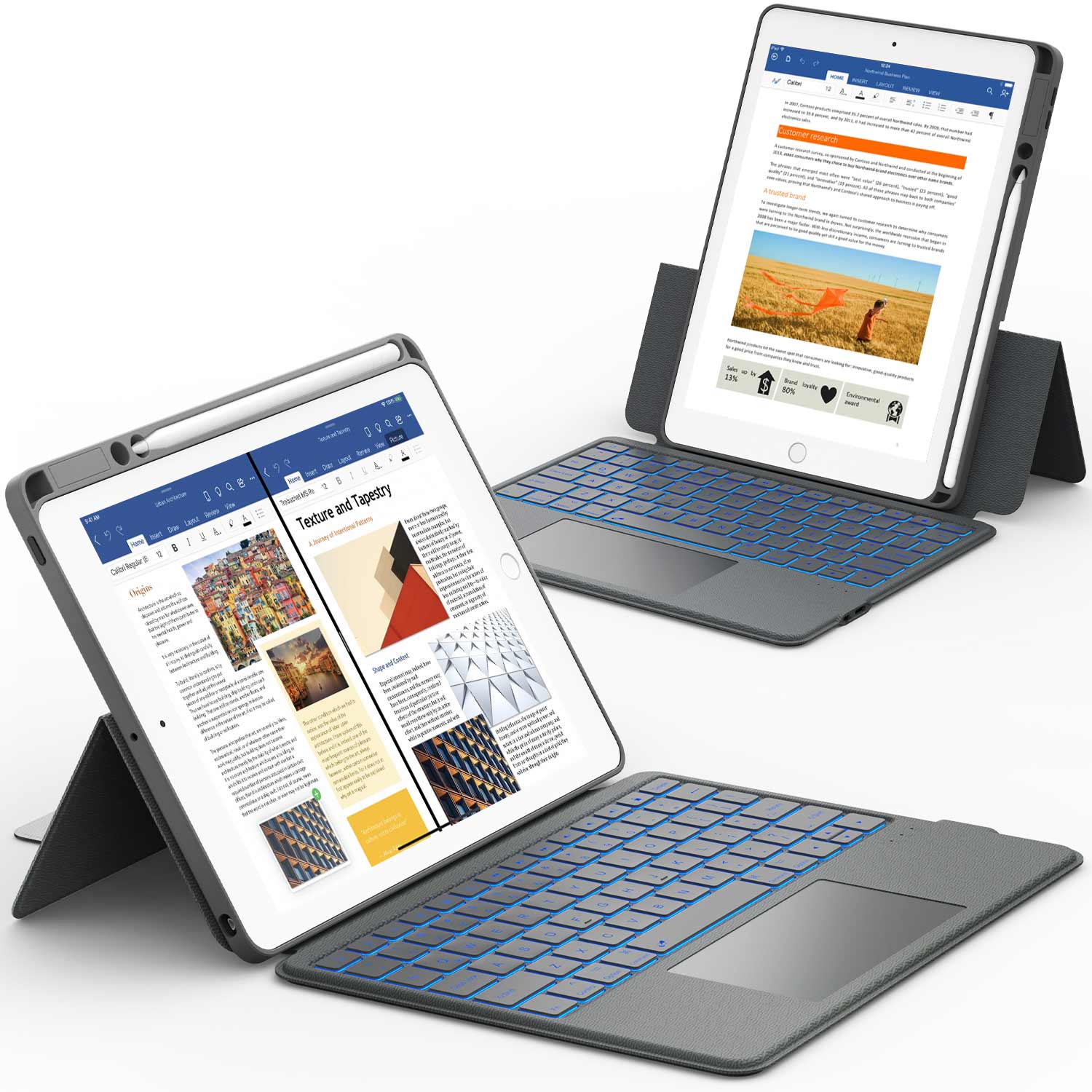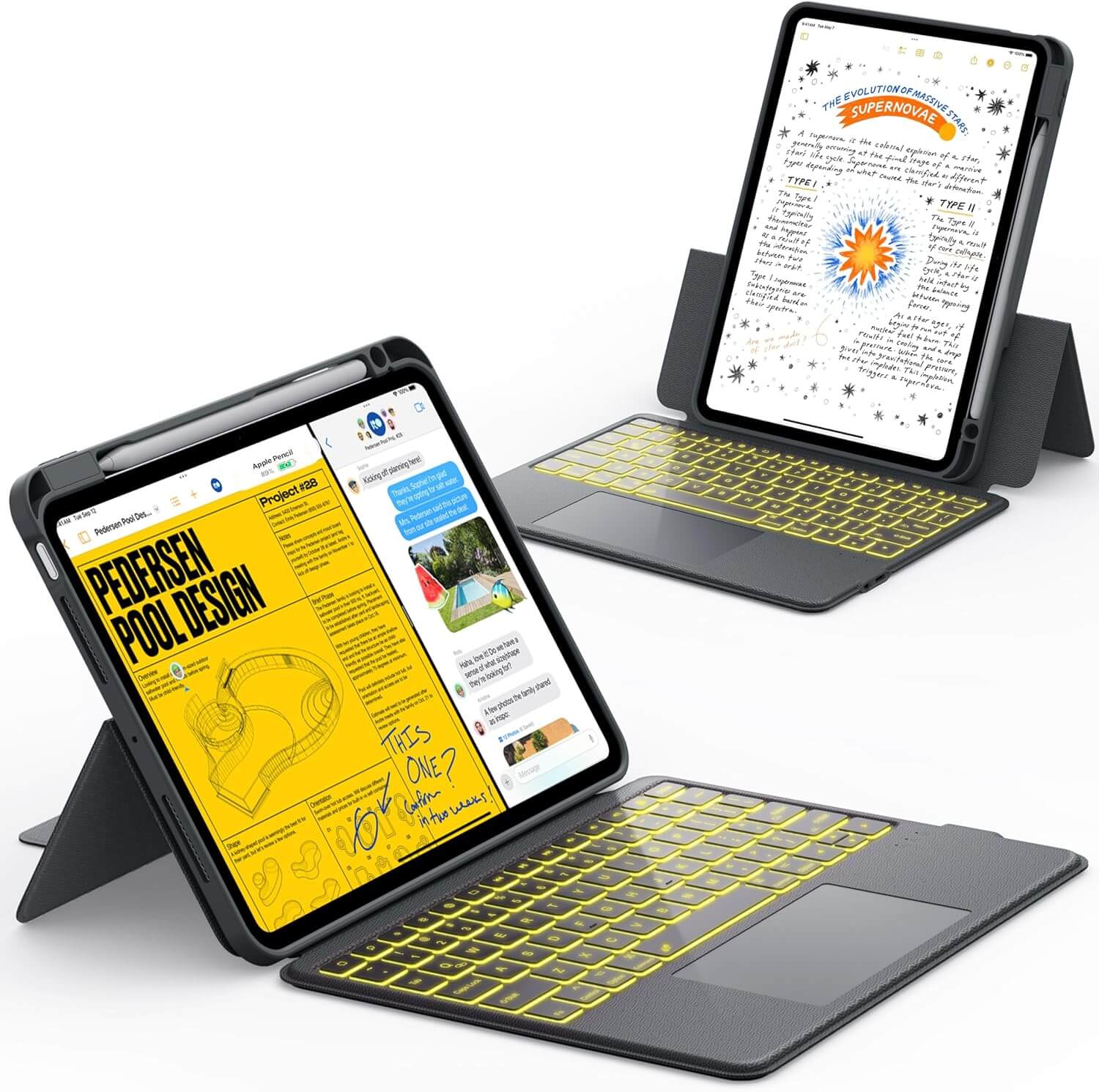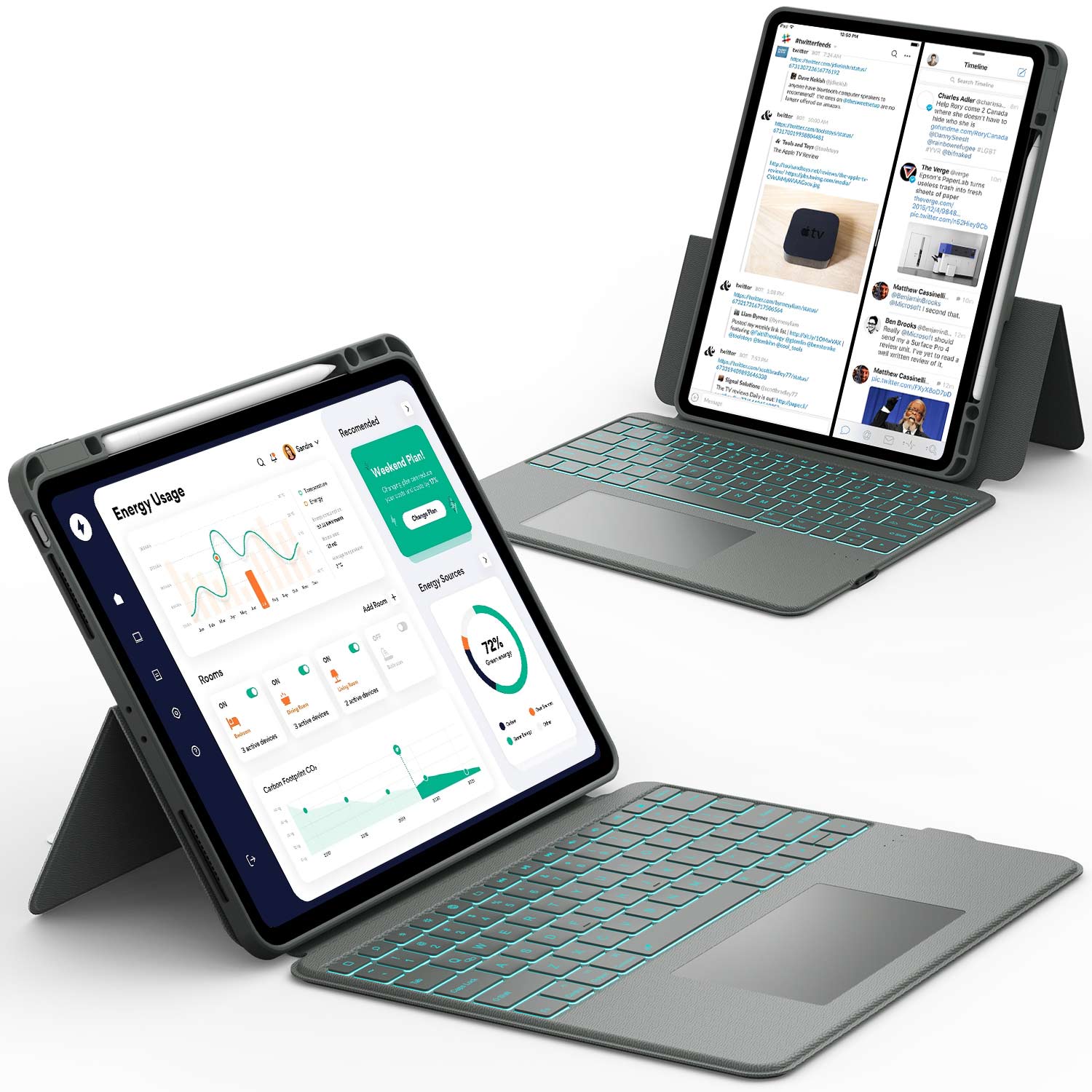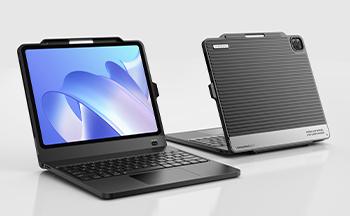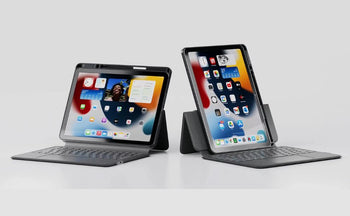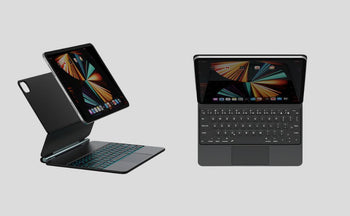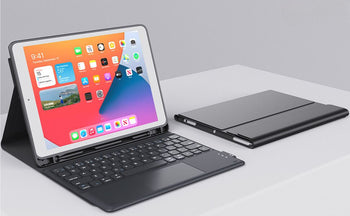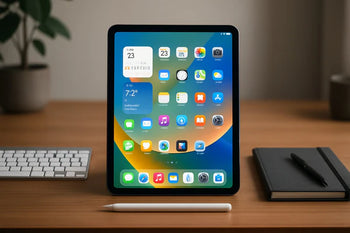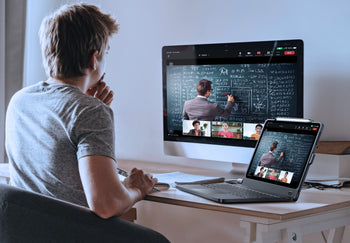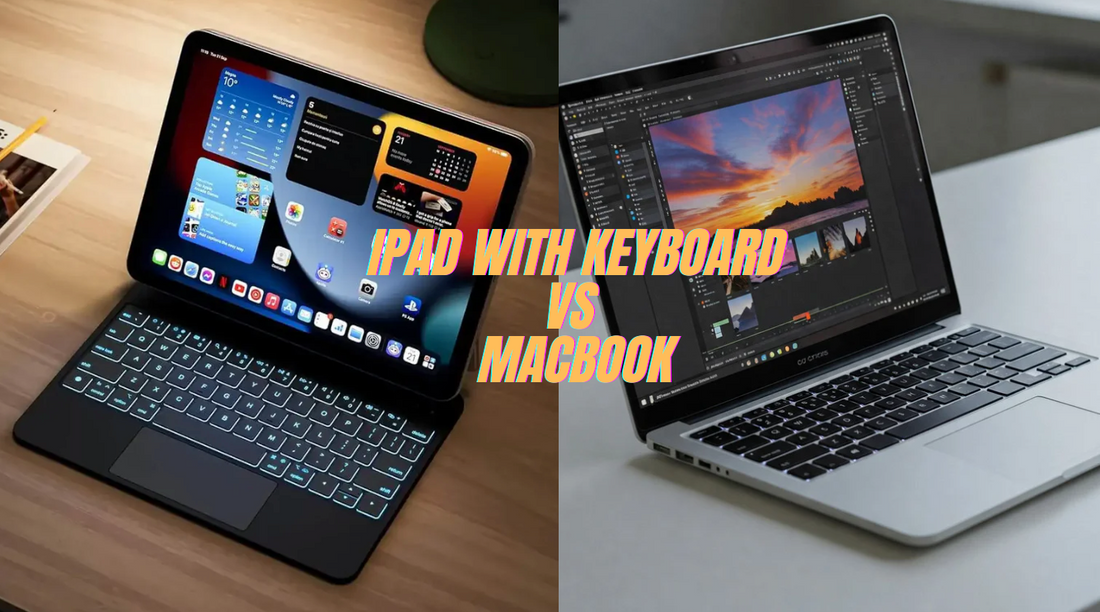iPad with Keyboard vs MacBook is a big question for anyone choosing a new Apple device. The iPad (including the iPad Pro and iPad Air) can be lightweight and flexible, perfect for drawing, taking notes, or reading on the go.
Pairing it with a Chesona Keyboard Case allows you to type documents and emails more naturally, making it feel closer to a MacBook.
The MacBook and MacBook Air are straightforward laptops that handle multitasking and more complex apps with ease. If you need a strong laptop for typing, editing, or programs you can’t get on an iPad, you’ll likely prefer the MacBook.
In this article, we compare the use of an iPad with a keyboard and a MacBook for school, work, and everyday tasks. Continue reading to determine whether an iPad with a keyboard or a MacBook is the best fit for you.
Quick Insights ⚡:
- iPad with keyboard excels in portability and touch functionality
- A MacBook is better for heavy-duty tasks and professional software
- iPad is more versatile (drawing, media consumption)
- MacBook offers a full desktop OS and better multitasking
iPad with Keyboard vs MacBook: Key Differences

[🛒 CHESONA Step Series Keyboard Case for iPad 10th 10.9'']
You’ll notice several major differences when comparing an iPad with a keyboard to a MacBook. Weight, design, and the operating systems set the two devices apart in how you use them daily.
Form Factor & Portability
An iPad with a keyboard is much lighter than a MacBook. You can use the iPad alone as a tablet for reading or watching shows.
When you attach a keyboard (like the Magic Keyboard), it becomes closer to a laptop.
The iPad's keyboard is separate and detachable. This lets you leave it off when you want to keep things light. The iPad, by itself, weighs only about 1 to 1.5 pounds, while the keyboard adds a bit more.
A MacBook, in comparison, has a built-in keyboard and typically weighs around 3 pounds.
Carrying an iPad with a keyboard is easier because you can take off the keyboard or keep it attached. The MacBook, being a single, solid piece, fits the standard laptop mold and features a clamshell design.
The iPad’s touchscreen and thin design make it versatile for various uses. If you travel frequently or enjoy moving around, the iPad combo is often simpler to pack.
Operating Systems Compared
The iPad uses iPadOS. This operating system is designed for touch-first use and simple navigation. You get big icons and multitasking with split-screen, and swipe gestures come naturally.
macOS runs on the MacBook. It’s designed for use with a trackpad and keyboard, and is better suited for working with multiple files and windows simultaneously.
You have access to desktop apps like Xcode or Final Cut Pro that do not work on iPadOS.
Key differences:
- iPadOS: Touch screen, mobile apps from the App Store, more limited desktop features.
- macOS: Full desktop experience, easier file management, more pro software available.
If you want touch controls and tablet features, the iPad stands out. If your work requires extensive file handling and desktop applications, a MacBook is a better fit.\
📌Also Read: Chromebook vs iPad (2025): Which Is Best for School & Work
Performance Showdown: iPad with Keyboard vs MacBook
When choosing between an iPad with a keyboard and a MacBook, the performance differences are significant. Processing power, multitasking capabilities, and the number of apps you can run will all affect your daily use.
Chip Performance (M-series vs A-series)
Both new MacBooks and top-end iPad Pros use Apple's M1 or M2 chips. These chips are fast, quiet, and capable of handling multiple tasks simultaneously.
MacBook:
- Uses the M1 or M2 chip with active cooling. This helps keep the chip running at high speeds without slowing down.
- Has more RAM options (up to 24GB on some models). This helps with large files or many apps.
- Better for heavy tasks like coding, video editing, and big spreadsheets.
iPad Pro:
- Also uses the M1 or M2 chip, but there is no active cooling. The chip might slow down if it gets too warm.
- RAM is capped at 8GB or 16GB, depending on the model.
- Good for creative apps, notes, and documents, but may slow down sooner under stress.
The primary difference lies in the cooling and RAM. The MacBook keeps the chip cool, allowing you to work longer on demanding tasks. The iPad remains quick for most tasks, but can lag with the most challenging jobs.
Multitasking & App Capabilities
The way you use apps and switch between them varies on each device. The MacBook provides a full desktop experience, while the iPad offers a more flexible tablet experience.
MacBook:
- Runs full versions of desktop apps like Adobe Photoshop, Final Cut Pro, and Microsoft Excel.
- Supports real multitasking, making it easy to run several large apps smoothly.
- Drag and drop files between apps in separate windows.
iPad with Keyboard:
- Offers mobile apps, though some (like Photoshop) now have desktop-class features.
- Multitasking is possible (via Split View or Slide Over), but you are still limited in the number of apps you can see side by side.
- Some tasks, such as exporting large media files, can be slower or less flexible.
If you need apps with every feature and want to use multiple windows at once, the MacBook is a better option.
The iPad is great for focused, one-at-a-time tasks, but less flexible for large projects that require multiple apps.
📌Also Read: 6 Common Mistakes Beginners Make in iPad Drawing
Productivity & Work Use Cases

[ 🔥CHESONA Step Series Keyboard Case for iPad Pro 11 M4🔥]
When deciding between an iPad with a keyboard and a MacBook for work, the primary differences lie in comfort, software, and how each device handles various tasks. Each has strengths that can make your daily work easier, depending on your needs.
Best for Typing & Long Documents
Typing long papers or creating reports is easier on a MacBook. You get a larger, more comfortable keyboard and a precise trackpad.
The keys have good travel and feedback, which helps reduce hand fatigue during long sessions.
With the iPad, you can type well enough for short messages, emails, and quick notes.
The keyboard on the Magic Keyboard is solid, but the setup is less stable on your lap. The iPad's smaller screen can feel cramped when working with two documents side by side.
Quick comparison:
-
MacBook:
- Larger keyboard with good key travel
- Reliable trackpad
- Great for multitasking and split-screen
- Works best for heavy writing
-
iPad:
- Magic Keyboard is good for short bursts
- Lightweight and easy to carry
- Compact screen limits multitasking
Creative Work (Design, Video Editing)
For drawing, sketching, or photo editing, the iPad stands out. Using the Apple Pencil with a Liquid Retina display feels natural.
Touch gestures and creative apps built for the iPad make it easy to draw, retouch photos, or make quick video edits. The iPad's battery life is also strong for long editing sessions on the go.
MacBook Air and MacBook Pro models, including ones with the M3 or M1 Apple Silicon chips, run more advanced software.
If you use apps like Final Cut Pro or Adobe Premiere, the MacBook's performance and memory can handle larger, more complex projects with faster exports and more storage options.
Key points:
-
iPad:
- Apple Pencil support
- Liquid Retina display
- Best for hands-on creative tasks
- Lighter, better for on-the-go sketches
-
MacBook:
- M1 and M3 chips boost performance
- More memory and storage choices
- Supports desktop creative software
- Handles big video files and multi-layer designs
📌Also Read: How to AirPlay from Mac to TV: Easy Setup Tutorial
Portability & Battery Life Compared

Choosing between an iPad with a keyboard and a MacBook often comes down to daily convenience and staying powered up.
Both devices have strengths that affect how easily they can be brought along and how long they last away from a charger.
Weight & Size Differences
The iPad with a keyboard is usually lighter and easier to carry than most MacBooks. Even with a keyboard attached, an iPad setup is slim and easy to fit in a small bag or backpack. Most iPad and keyboard combos weigh around 1.5 to 2 pounds.
A MacBook Air is still very portable, but it is bulkier and a bit heavier. The latest models weigh about 2.7 to 3 pounds. This means you might notice the extra weight if you are carrying it all day in a bag.
Key differences to consider:
- iPad with keyboard: Lightweight, thinner, can detach keyboard for even less bulk
- MacBook Air: Slightly heavier, one-piece design, always the same weight
If you want the easiest device to take anywhere, the iPad with a keyboard usually wins in travel-friendliness.
Battery Life in Real-World Use
The MacBook Air provides long-lasting battery performance, particularly during extended work sessions.
It often lasts up to 18 hours when browsing or using typical work software. This makes it reliable for full days of writing, editing, or working online.
The iPad has good battery life for watching videos, reading, or browsing. It can last about 10 hours when streaming or using most apps.
However, battery life drops significantly with heavy tasks, such as video editing or running multiple apps simultaneously.
- MacBook Air: Longer battery for full workdays
- iPad with keyboard: Great for light use and media, but drains quicker for heavy work
If you need a device that can handle multiple tasks for extended periods, the MacBook Air is a better option. For shorter sessions or casual use, the iPad battery is enough.
📌Also Read: iPad Keyboard Not Working? 10 Fixes You Should Try Today
Price & Value Breakdown
When comparing iPad models with a keyboard to a MacBook, it is essential to consider both the upfront cost and the longevity of each device. The cost and value can vary significantly depending on your needs and device usage.
Base Model Costs
The base iPad Pro or iPad Air costs less than the MacBook Air at first. However, once you add a keyboard case, the total price increases.
|
Device |
Base Price |
Keyboard Cost |
Total Starting Price |
|
iPad Air (Base) |
$599 |
~$200 |
~$799 |
|
iPad Pro 11" (Base) |
$999 |
~$350 |
~$1349 |
|
MacBook Air 13" (Base) |
$999 |
Included |
$999 |
|
MacBook Air 15" (Base) |
$1299 |
Included |
$1299 |
The MacBook Air comes with a built-in keyboard and trackpad. You do not have to buy anything extra for typing.
When you add a keyboard case to an iPad, it can increase the total cost to close to or even higher than that of a MacBook Air.
You should also think about storage. The MacBook Air often offers more storage at the entry-level than the base iPad.
Long-Term Value & Upgradability
MacBook Air models often get macOS updates for 6 years or more. They can last a long time with software support.
iPads receive frequent updates, but some features require newer models. Most iPads cannot be upgraded, and battery replacements are more difficult and cost extra.
Key points for long-term use:
- MacBooks often last longer before becoming outdated
- iPads get fast software updates, but may not support every new feature on older models
- You cannot add more storage or memory to either device later
- Both keep their value well, but MacBook resale prices usually stay higher
Consider how often you want to replace your device and whether you will need support for many years.
Who Should Buy an iPad with a Keyboard?

[ 🔥CHESONA Rugged Series Keyboard Case for iPad Pro 11'' (M4, 2024)🔥]
Consider an iPad with a keyboard if you need a device that is lightweight, flexible, and easy to use in various settings.
The iPad with a keyboard offers more options than a regular laptop, especially if you enjoy using touchscreen features.
Best for:
-
Students
- Great for taking notes in class.
- Easy to carry between classes or on the go.
- Good for reading and streaming videos.
-
Artists and Designers
- Works well with the Apple Pencil for drawing or editing photos.
- A touchscreen is better for digital art apps.
-
Casual Users
- If you mostly browse the web, check email, or stream music and movies.
- Enjoy switching between using a keyboard and touch screen.
- Perfect for travel due to its compact size.
The iPad with a keyboard is also helpful if you want a device that can act as both a tablet and a laptop. If you don't need to run full versions of laptop software, such as desktop apps, the iPad is often enough for most daily tasks.
You can also detach the keyboard when you just want to use the iPad as a tablet. This makes it good for relaxing, playing games, or reading ebooks.
📌Also Read: Best iPad Stands for Artists, Students, and Professionals
Who Should Buy a MacBook Instead?
A MacBook is the better choice when you need a real laptop experience. If you use programs like Adobe Photoshop, Final Cut Pro, or coding tools, a MacBook will work faster and let you do more at the same time.
Consider a MacBook if you:
- Need to run full desktop apps, such as Microsoft Office, Xcode, or professional design software
- Type for long periods (the built-in keyboard makes this more comfortable)
- Want to connect to several devices or monitors without using adapters
- Prefer easy multitasking with features like multiple windows and better file management
Professionals who edit videos, build software, or use complex spreadsheets will find that the MacBook meets their needs than an iPad with a keyboard. Writers and office workers who type many pages each day will also enjoy the larger keyboard and trackpad.
If you frequently need to transfer files between folders or work with external drives, the MacBook makes it easy. It is also a safer pick if you must use apps that are not available for iPadOS.
A MacBook is also helpful if you want a device that feels familiar, like a regular laptop, and provides you with access to all the tools you need without limitations.
Final Thoughts
When comparing an iPad with a keyboard to a MacBook, it's helpful to focus on what you need most in your daily life.
If you're looking for something lightweight, slim, and easy to carry anywhere, the iPad stands out. Pairing it with a keyboard gives you a simple way to type, browse, and draw on the go.
For work that requires advanced software or extensive multitasking, a MacBook will likely serve you better. It runs full desktop apps like Xcode, Photoshop, and Microsoft Office.
Think about how often you use a touchscreen or need to write, sketch, or watch shows. If you enjoy these things, you might enjoy what the iPad offers.
If typing, coding, and long writing sessions are part of your routine, the MacBook’s keyboard, screen, and software will feel familiar and powerful.
Ask yourself: Do you need a device that can sometimes be a laptop, or do you need a laptop that does it all? This question can point you toward the best fit for your needs.
❓FAQs About iPad with Keyboard vs MacBook
When choosing between an iPad with a keyboard and a MacBook, consider performance, comfort, and how you intend to use your device. Each option is better suited for specific tasks and has its own strengths and weaknesses.
Can an iPad with keyboard replace a MacBook?
You can use an iPad with a keyboard for many of the same tasks as a MacBook, like browsing the internet, writing documents, and sending emails. However, there are some things the MacBook does better.
If you need to run full desktop apps or use advanced software, a MacBook is usually the better choice. The iPad is best for light productivity and media consumption.
Which is better for college students?
A MacBook is better if you need to use professional software, code, or do a lot of multitasking for school. It supports a wide range of programs and is more flexible for complex work.
The iPad is lighter and has a long battery life. It works well for taking notes, reading, and simple assignments, especially when paired with a keyboard.
Is the iPad keyboard as good as a MacBook's?
The MacBook’s keyboard is larger and more comfortable for most people, especially when typing for long periods. The keyboard is built-in and sturdy.
The iPad’s keyboards, like the Magic Keyboard, are smaller and may feel less stable on your lap. They still work well for light typing, but the experience is not quite the same as a MacBook.
Do iPads get viruses like MacBooks?
Both iPads and MacBooks are designed with security in mind. iPads use a locked-down operating system, which makes it harder for viruses to infect the device.
MacBooks are also very secure, but they can be more vulnerable to malware if you download software from unsafe sources. Regular updates and safe browsing help protect both devices.
